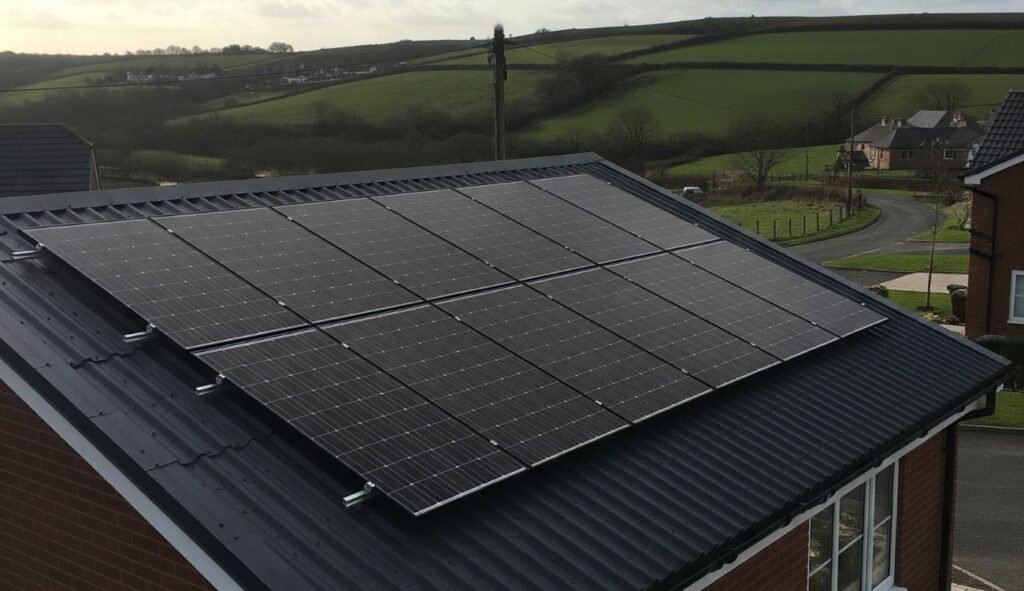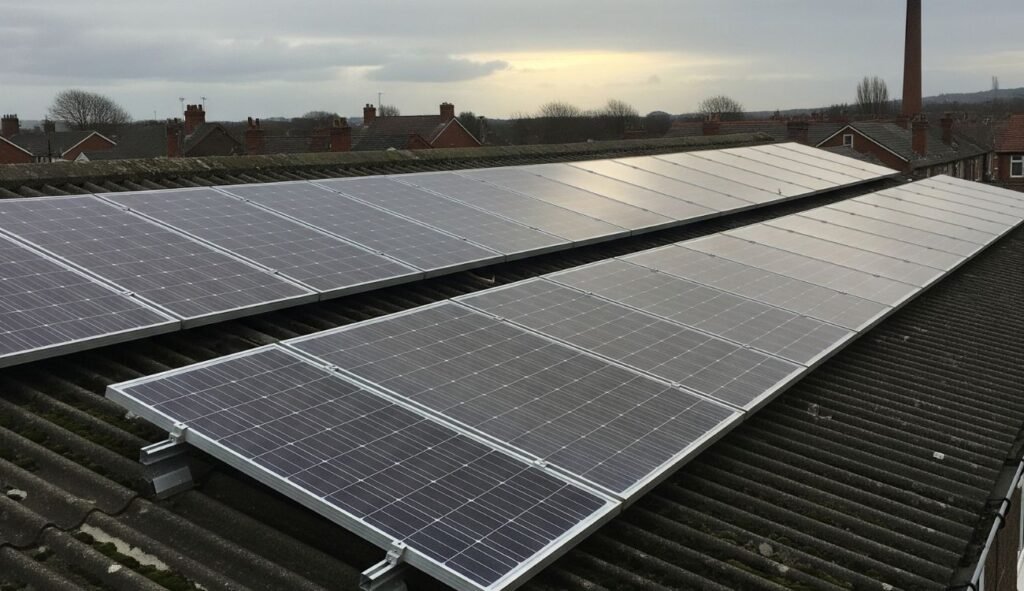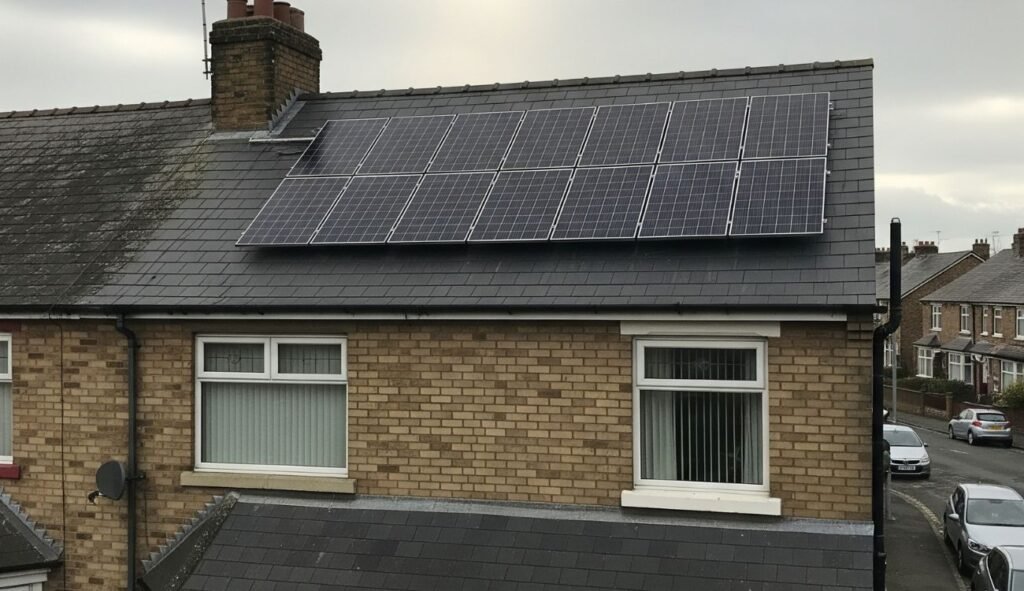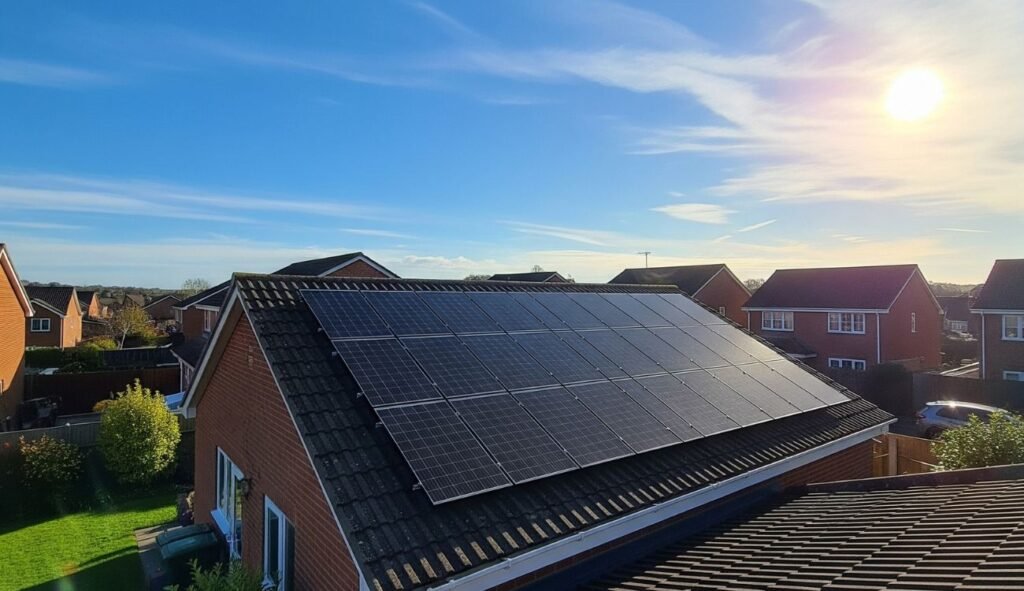Fibreglass roofing is becoming increasingly popular across the UK thanks to its durability, weather resistance, and long lifespan. But many homeowners and landlords are left wondering, can you install solar panels on a fibreglass roof?
The answer is yes, but it comes with specific considerations that are crucial to ensure safety, performance, and structural integrity.
In this guide, we’ll explore how solar panels can be mounted on fibreglass roofs, the benefits and challenges involved, the types of mounting systems used, and financial incentives available to UK property owners.
Whether you’re looking to cut your energy bills or invest in renewable energy, this article will help you make an informed decision.
Can Solar Panels Be Safely Mounted On A Fibreglass Roof?
Yes, solar panels can be installed on fibreglass roofs in the UK—but the method of installation is different compared to traditional tiled or slate roofs.
Fibreglass (GRP – Glass Reinforced Plastic) roofs are lightweight and seamless, making them less prone to leaks. However, their smooth surface and relatively low load-bearing capacity require careful assessment before mounting solar panels.
Tip: If you’re dealing with a flat surface, understanding the specifics of installing solar panels on a flat roof can help clarify what to expect.
Key Considerations:
- Weight distribution: Solar panels typically weigh 18–25kg per panel. This load must be evenly distributed to avoid stress fractures or structural damage. For roofs with limited surface area or structural capacity, it’s important to consider how many solar panels you can realistically fit on your roof based on available space and safe loading.
- Mounting system: Special non-penetrative racking or ballast systems are often used to avoid drilling into the fibreglass membrane.
- Weatherproofing: Penetrative mounts (if used) must be sealed professionally to maintain waterproofing and prevent roof degradation over time.
- Warranty: Check if the fibreglass roofing warranty covers third-party installations such as solar systems.
Tip: Before installing, it’s essential to conduct a structural survey. A qualified solar installer like Future Heat can assess your roof’s suitability and provide tailored recommendations.
What Mounting Systems Are Used On Fibreglass Roofs?
Installing solar panels on fibreglass roofs typically requires a customised approach. There are two main types of systems used:
1. Ballasted Mounting Systems
These systems rely on weights to secure the panels in place rather than drilling. Ideal for flat or gently sloped fibreglass roofs, they reduce the risk of water ingress.
2. Non-Penetrative Clamps or Adhesive Mounts
Some installers use adhesive mounting brackets designed specifically for fibreglass or lightweight roof materials. These must be installed by professionals and tested for extreme weather resilience.
Professional installers will always recommend the safest system based on your roof’s size, pitch, and orientation. For context, solar panel systems used on concrete roofs, garage roofs, or rubber roofs offer similar non-penetrative options.
Professional installers will always recommend the safest system based on your roof’s size, pitch, and orientation.
For anyone new to solar, knowing how to select the right solar installer can make a big difference in project success and peace of mind.
Are Fibreglass Roofs Commonly Found On UK Properties?
Fibreglass roofs are especially common on:
- Flat-roof extensions
- Garages
- Commercial units
- Outbuildings and sheds
- Some modern new builds
Their longevity (20–30 years) and low maintenance make fibreglass roofs an attractive option for landlords and those evaluating whether commercial solar panels are worth it in the UK.
However, their compatibility with solar PV needs proper planning.
What Government Grants Or Incentives Are Available In The UK?
Solar energy adoption is supported by several UK schemes and incentives in 2025:
1. Smart Export Guarantee (SEG)
Offered by licensed energy suppliers, the Smart Export Guarantee (SEG) pays you for surplus electricity you export back to the grid. Rates vary but range from 2p to 15p per kWh.
2. Zero VAT on Solar Panels
Until March 2027, the UK government has removed VAT on domestic solar panel installations. This could save households up to £1,000 on installation costs.
3. ECO4 Scheme
While primarily focused on insulation and heating, some homeowners may be eligible for renewable upgrades through the ECO4 scheme if on qualifying benefits.
Can Solar Panels Improve Property Value And EPC Ratings?
Absolutely. Installing solar panels can improve your Energy Performance Certificate (EPC) rating, which is especially beneficial for landlords under the Minimum Energy Efficiency Standards (MEES).
- Properties must have an EPC rating of E or above to be legally rented in the UK.
- Homes with solar PV can increase in value by 2–4%.
- Plus, solar systems help you reduce energy bills year-round, even during colder months. Read our article to understand how solar panels perform in winter.
Is Planning Permission Required For Solar Panels On Fibreglass Roofs?
In most cases, no planning permission is required, as solar panels fall under Permitted Development Rights for domestic properties. However:
- Listed buildings and conservation areas may have restrictions.
- Flat roofs (often the case with fibreglass) may need prior approval depending on panel height and visibility.
Frequently Asked Questions (FAQs)
Yes, many garage roofs use fibreglass materials. If structurally sound, solar panels can be mounted using ballasted or adhesive systems without damaging the surface.
Possibly. Always check the terms of your roof warranty—some manufacturers void warranties if penetrative mounts are used. A reputable installer like Future Heat will offer solutions that preserve warranty conditions.
Properly installed solar panels will not reduce the lifespan of a fibreglass roof. In fact, they can offer protection from UV rays and weathering. Expect both to last 20–30 years when maintained.
Slightly. Custom mounting systems may increase installation costs by 5–10%. However, this is often offset by the ease of working on flat fibreglass roofs compared to pitched ones.
Yes—if your panels are installed by a certified installer and your home insurance policy includes coverage for renewable energy systems. Always notify your insurer after installation.
Our Verdict
Fibreglass roofs offer a solid foundation for solar panel installation if approached with the right equipment and expertise.
Whether you own a residential extension, a rental property, or a commercial building, solar energy can help reduce costs, improve energy efficiency, and even increase property value.
Many UK homeowners see a noticeable drop in expenses. Therefore, understanding the average monthly electricity bill with solar panels could help you estimate your potential savings and justify an installation quote.
With government incentives like SEG and zero VAT, there’s never been a better time to invest in solar power in the UK.
If you’re already assessing feasibility and roof compatibility, it’s also worth knowing when the best time to install solar panels in the UK is. Timing your installation right can maximise system performance and installer availability.
And if you’re weighing up long-term savings, it’s worth understanding how long until solar panels pay for themselves. You may be pleasantly surprised by the payback period.
Myles Robinson is a seasoned expert in the boiler and home improvement industry, with over a decade of experience. He is deeply committed to environmental sustainability, actively promoting energy-efficient heating solutions to help households reduce their carbon footprint. By combining industry expertise with a dedication to environmental responsibility, Myles continues to lead efforts in transforming home heating practices towards a more sustainable future.











